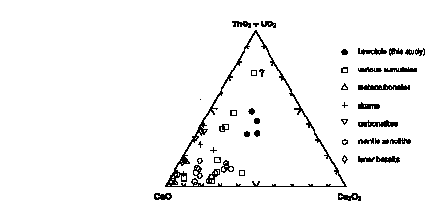
The rare mineral zirconolite (CaZrTi2O7) is present as an accessory phase in potassium-rich calc-alkaline subduction related lavas from Lewotolo volcano, East Sunda Arc, Indonesia. To the best of our knowledge, this is the first reported occurrence of zirconolite in terrestrial extrusive rocks other than carbonatites and kimberlites. In terms of Ca, Ti and Zr contents, the Lewotolo zirconolites are closer to those found in pegmatite, mantle xenoliths and lunar basalts, than to those reported from various mafic and acid cumulates, carbonatites, and kimberlites. Detailed electron microprobe analyses show high contents of Th, U, and REE (up to 6.7, 4.3, and 15 wt.% oxide, respectively) substituting for Ca, and the highest Fe contents yet reported (up to 11.4 wt.% Fe2O3t), which distinguishes these zirconolites from all others reported from different rock types (Fig. 1).
Small (3-10 mm) euhedral crystals of the mineral are always associated with a hydrated silica phase, which is present in the vesicles of several of the lavas. Host rocks containing zirconolite are relatively evolved (57 - 62 wt.% SiO2), but there is no obvious relation between lava composition and zirconolite presence. These textural and petrologic observations suggest that zirconolite crystallised during a late magmatic event, probably involving hot fluids. Hence Zr, Ti, REE, Th, and U must have been mobile when crystallisation had (almost) come to an end. Because formation of complexes with halogens will promote HFSE and REE mobility, and Lewotolo magmas are rich in fluorine, we believe that halogen-rich fluids played an important role in redistributing these elements. Other accessory minerals identified in several of the lavas, such as fluorine-rich apatite, monazite, zircon, thorite, and (?)chevkinite/perrierite, are enriched in these elements as well. However, as they are typical groundmass phases and not associated with vesicles and silica, they probably formed somewhat earlier during magmatic crystallisation.
If the fluids from which the zirconolites precipitated were an exsolved phase in cooling magma, the implication is that trace elements contents of Lewotolo lavas not necessarily represent magma compositions. Our findings suggest that loss of HFSE, REE, Th, and U from magma batches by late-stage processes may not be insignificant for conventional trace-element modelling of magma evolution, particularly in the case of halogen-rich systems. Th/U ratios in the Lewotolo zirconolites average around 2.7, which is less than the bulk rock ratios of the lavas (~4), which suggests a difference in mobility between these elements during late magmatic stages. Th-U disequilibrium studies should take the possibility of such fractionation in arc volcanoes into account.
Fig. 1: Ca-substitution in Lewotolo zirconolites compared to literature data on zirconolites from various rock types.